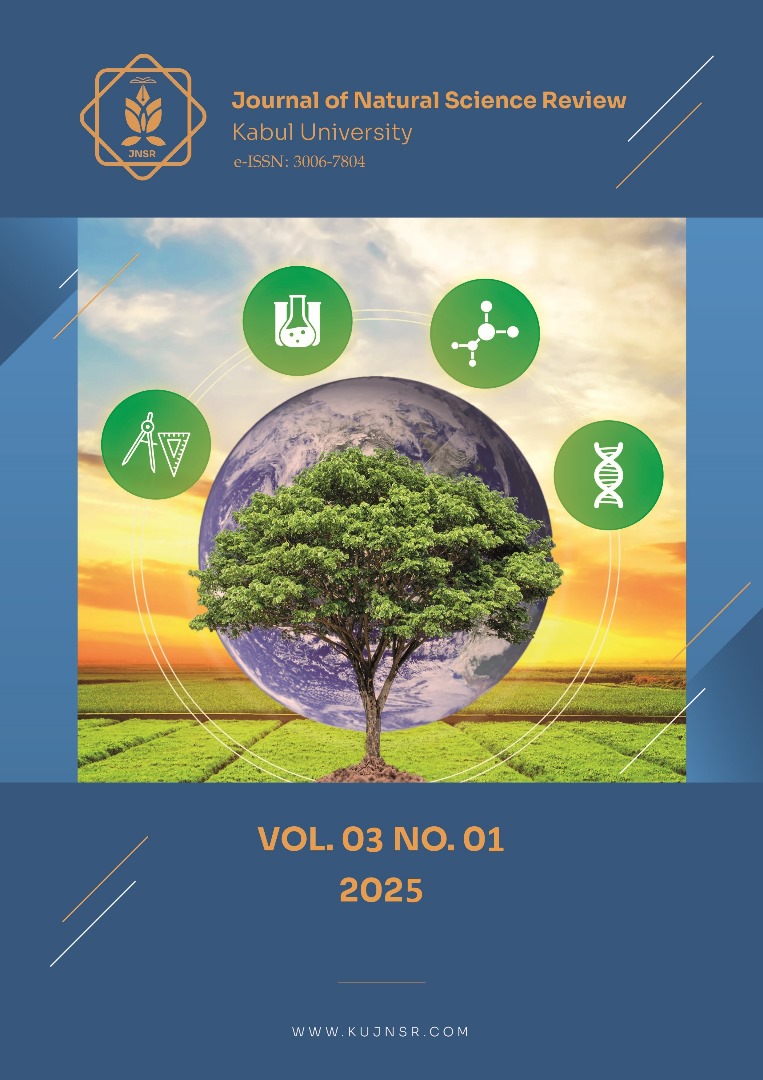Environmental Fate and Toxicity of Zinc Oxide Nanoparticles in Aquatic Ecosystems: A Comprehensive Review
DOI:
https://doi.org/10.62810/jnsr.v3i1.103Keywords:
Nanoparticles, ZnO NPs, Aquatic ecosystem, Environmental fate, EcotoxicityAbstract
Zinc oxide nanoparticles (ZnO NPs) are increasingly utilized in agriculture, electronics, and medicine, raising concerns about their environmental fate and toxicity in aquatic ecosystems. This study aims to review the fate, bioaccumulation, and toxicity of ZnO NPs in aquatic ecosystem. This review was conducted through a comprehensive analysis of peer-reviewed literature from databases such as Scopus, Web of Science, and PubMed. Finding indicates that ZnO NP fate in aquatic ecosystems is governed by key environmental factors, including pH, ionic strength, and DOM. ZnO NPs tend to aggregate in high-salinity environments, whereas acidic conditions enhance dissolution, leading to increased Zn²⁺ ion release and potential toxicity. Smaller ZnO NPs exhibit higher reactivity and bioavailability, increasing their potential for bioaccumulation. Bioaccumulation of ZnO NPs is influenced by concentration, exposure time, and particle size, with smaller nanoparticles being more readily absorbed by aquatic organisms. Toxicity varies depending on exposure duration and environmental conditions, with DOM playing a mitigating role by reducing Zn²⁺ ion availability. Additionally, ZnO NP exposure has been linked to oxidative stress, developmental abnormalities, and behavioral changes in aquatic organisms, highlighting the need for regulations and tailored risk assessments that account for water chemistry variations to mitigate ecological risks. Future research should focus on long-term impacts, including multi-species interactions and trophic transfer, to improve mitigation strategies.
Downloads
References
Adams, L. K., Lyon, D. Y., & Alvarez, P. J. (2006). Comparative eco-toxicity of nanoscale TiO2, SiO2, and ZnO water suspensions. Water Research, 40(19), 3527-3532. DOI: https://doi.org/10.1016/j.watres.2006.08.004
Amde, M., Liu, J. F., Tan, Z. Q., & Bekana, D. (2017). Transformation and bioavailability of metal oxide nanoparticles in aquatic and terrestrial environments. A review. Environmental Pollution, 230, 250-267. DOI: https://doi.org/10.1016/j.envpol.2017.06.064
Amin, N., Vedi, F., Wais, M. N., Zulkifli, S. Z., Amal Azmai, M. N., & Ismail, A. (2024). Developmental Toxicity of Zinc Oxide Nanoparticles on the Early Life Stage of Java Medaka (Oryzias javanicus Bleeker, 1856). Pertanika Journal of Tropical Agricultural Science, 47(2). DOI: https://doi.org/10.47836/pjtas.47.2.16
Amin, N., Zulkifli, S. Z., Azmai, M. N. A., & Ismail, A. (2021). Toxicity of zinc oxide nanoparticles on the embryo of javanese medaka (Oryzias javanicus Bleeker, 1854): A comparative study. Animals, 11(8), 2170. DOI: https://doi.org/10.3390/ani11082170
Appierot, G., Lipovsky, A., Dror, R., Perkas, N., Nitzan, Y., Lubart, R., & Gedanken, A. (2009). Enhanced antibacterial activity of nanocrystalline ZnO due to increased ROS-mediated cell injury. Advanced Functional Materials, 19(6), 842–852. DOI: https://doi.org/10.1002/adfm.200801081
Auffan, M., Rose, J., Wiesner, M. R., & Bottero, J. Y. (2009). Chemical stability of metallic nanoparticles: a parameter controlling their potential cellular toxicity in vitro. Environmental Pollution, 157(4), 1127-1133. DOI: https://doi.org/10.1016/j.envpol.2008.10.002
Bai, W., Zhang, Z., Tian, W., He, X., Ma, Y., Zhao, Y., & Chai, Z. (2010). Toxicity of zinc oxide nanoparticles to zebrafish embryo: a physicochemical study of toxicity mechanism. Journal of Nanoparticle Research, 12(5), 1645-1654. DOI: https://doi.org/10.1007/s11051-009-9740-9
BCC Research. (2019) Nanotechnology and Advanced Materials Research Review. Retrieved from https://www.bccresearch.com/market-research/nanotechnology/nanotechnology-fuel-cell-research-review.html
BCC Research. (2021). Nanobiotechnology: Applications and Global Markets. Retrieved from https://www.bccresearch.com/market-research/nanotechnology/nanobiotechnology-market.html
Bhuvaneshwari, M., Sagar, B., Doshi, S., Chandrasekaran, N., & Mukherjee, A. (2017). Comparative study on toxicity of ZnO and TiO 2 nanoparticles on Artemia salina: effect of pre-UV-A and visible light irradiation. Environmental Science and Pollution Research, 24, 5633-5646. DOI: https://doi.org/10.1007/s11356-016-8328-z
Blinova, I., Ivask, A., Heinlaan, M., Mortimer, M., & Kahru, A. (2010). Ecotoxicity of nanoparticles of CuO and ZnO in natural water. Environmental Pollution, 158(1), 41-47. DOI: https://doi.org/10.1016/j.envpol.2009.08.017
Bordin, E. R., Ramsdorf, W. A., Domingos, L. M. L., de Souza Miranda, L. P., Mattoso Filho, N. P., & Cestari, M. M. (2024). Ecotoxicological effects of zinc oxide nanoparticles (ZnO-NPs) on aquatic organisms: Current research and emerging trends. Journal of Environmental Management, 349, 119396. DOI: https://doi.org/10.1016/j.jenvman.2023.119396
Brun, N. R., Lenz, M., Wehrli, B., & Fent, K. (2014). Comparative effects of zinc oxide nanoparticles and dissolved zinc on zebrafish embryos and eleuthero-embryos: importance of zinc ions. Science of the Total Environment, 476, 657-666. DOI: https://doi.org/10.1016/j.scitotenv.2014.01.053
Caballero-Guzman, A., & Nowack, B. (2016). A critical review of engineered nanomaterial release data: Are current data useful for material flow modeling?. Environmental Pollution, 213, 502-517. DOI: https://doi.org/10.1016/j.envpol.2016.02.028
Callaghan, N. I., & MacCormack, T. J. (2017). Ecophysiological perspectives on engineered nanomaterial toxicity in fish and crustaceans. Comparative Biochemistry and Physiology Part C: Toxicology & Pharmacology, 193, 30-41. DOI: https://doi.org/10.1016/j.cbpc.2016.12.007
Chen, T. H., Lin, C. C., & Meng, P. J. (2014). Zinc oxide nanoparticles alter hatching and larval locomotor activity in zebrafish (Danio rerio). Journal of Hazardous Materials, 277, 134-140. DOI: https://doi.org/10.1016/j.jhazmat.2013.12.030
Cong, Y., Jin, F., Wang, J., & Mu, J. (2017). The embryotoxicity of ZnO nanoparticles to marine medaka, Oryzias melastigma. Aquatic Toxicology, 185, 11-18. DOI: https://doi.org/10.1016/j.aquatox.2017.01.006
Das, S., Giri, S., Jose, S.A., Pulimi, M., Anand, S., Chandrasekaran, N., Rai, P.K. & Mukherjee, A. (2023). Comparative toxicity assessment of individual, binary and ternary mixtures of SiO2, Fe3O4, and ZnO nanoparticles in freshwater microalgae, Scenedesmus obliquus: Exploring the role of dissolved ions. Comparative Biochemistry and Physiology Part C: Toxicology & Pharmacology, 273, 109718. DOI: https://doi.org/10.1016/j.cbpc.2023.109718
Degen, A., & Kosec, M. (2000). Effect of pH and impurities on the surface charge of zinc oxide in aqueous solution. Journal of the European Ceramic Society, 20(6), 667-673. DOI: https://doi.org/10.1016/S0955-2219(99)00203-4
Du, J., Cai, J., Wang, S., & You, H. (2017). Oxidative stress and apotosis to zebrafish (Danio rerio) embryos exposed to perfluorooctane sulfonate (PFOS) and ZnO nanoparticles. International Journal of Occupational Medicine and Environmental Health, 30(2), 213-229. DOI: https://doi.org/10.13075/ijomeh.1896.00669
Ealia, S. A. M., & Saravanakumar, M. P. (2017). A review on the classification, characterisation, synthesis of nanoparticles and their application. In IOP Conference Series: Materials Science and Engineering (Vol. 263, No. 3, p. 032019). IOP Publishing. DOI: https://doi.org/10.1088/1757-899X/263/3/032019
Fabrega, J., Tantra, R., Amer, A., Stolpe, B., Tomkins, J., Fry, T., Lead, J. R., Tyler, C. R., & Galloway, T. S. (2012). Sequestration of zinc from zinc oxide nanoparticles and life cycle effects in the sediment dweller amphipod Corophium volutator. Environmental Science & Technology, 46(2), 1128-1135. DOI: https://doi.org/10.1021/es202570g
Franklin, N. M., Rogers, N. J., Apte, S. C., Batley, G. E., Gadd, G. E., & Casey, P. S. (2007). Comparative toxicity of nanoparticulate ZnO, bulk ZnO, and ZnCl2 to a freshwater microalga (Pseudokirchneriella subcapitata): the importance of particle solubility. Environmental Science & Technology, 41(24), 8484-8490. DOI: https://doi.org/10.1021/es071445r
García-Gómez, C., García-Gutiérrez, S., Obrador, A., & Fernández, M. D. (2020). Study of Zn availability, uptake, and effects on earthworms of zinc oxide nanoparticle versus bulk applied to two agricultural soils: Acidic and calcareous. Chemosphere, 239, 124814. DOI: https://doi.org/10.1016/j.chemosphere.2019.124814
Ghafarifarsani, H., Hedayati, S. A., Yousefi, M., Hoseinifar, S. H., Yarahmadi, P., Mahmoudi, S. S., & Van Doan, H. (2023). Toxic and bioaccumulative effects of zinc nanoparticle exposure to goldfish, Carassius auratus (Linnaeus, 1758). Drug and Chemical Toxicology, 46(5), 984-994. DOI: https://doi.org/10.1080/01480545.2022.2115509
Griffitt, R. J., Hyndman, K., Denslow, N. D., & Barber, D. S. (2009). Comparison of molecular and histological changes in zebrafish gills exposed to metallic nanoparticles. Toxicological Sciences, 107(2), 404-415. DOI: https://doi.org/10.1093/toxsci/kfn256
Guo, S., Dong, S., & Wang, E. (2009). Polyaniline/Pt hybrid nanofibers: High‐efficiency nanoelectrocatalysts for electrochemical devices. Small, 5(16), 1869-1876. DOI: https://doi.org/10.1002/smll.200900190
Gupta, G. S., Senapati, V. A., Dhawan, A., & Shanker, R. (2017). Heteroagglomeration of zinc oxide nanoparticles with clay mineral modulates the bioavailability and toxicity of nanoparticle in Tetrahymena pyriformis. Journal of Colloid and Interface Science, 495, 9-18. DOI: https://doi.org/10.1016/j.jcis.2017.01.101
Handy, R. D., Kammer, F. V. D., Lead, J. R., Hassellöv, M., Owen, R., & Crane, M. (2008). The ecotoxicology and chemistry of manufactured nanoparticles. Ecotoxicology, 17(4), 287-314. DOI: https://doi.org/10.1007/s10646-008-0199-8
Hao, L., Chen, L., Hao, J., & Zhong, N. (2013). Bioaccumulation and sub-acute toxicity of zinc oxide nanoparticles in juvenile carp (Cyprinus carpio): a comparative study with its bulk counterparts. Ecotoxicology and Environmental Safety, 91, 52-60. DOI: https://doi.org/10.1016/j.ecoenv.2013.01.007
Hazeem, L. (2022). Single and combined toxicity effects of zinc oxide nanoparticles: uptake and accumulation in marine microalgae, toxicity mechanisms, and their fate in the marine environment. Water, 14(17), 2669. DOI: https://doi.org/10.3390/w14172669
Heinlaan, M., Ivask, A., Blinova, I., Dubourguier, H. C., & Kahru, A. (2008). Toxicity of nanosized and bulk ZnO, CuO and TiO2 to bacteria Vibrio fischeri and crustaceans Daphnia magna and Thamnocephalus platyurus. Chemosphere, 71(7), 1308-1316. DOI: https://doi.org/10.1016/j.chemosphere.2007.11.047
Hou, J., Liu, H., Zhang, S., Liu, X., Hayat, T., Alsaedi, A., & Wang, X. (2019). Mechanism of toxic effects of Nano-ZnO on cell cycle of zebrafish (Danio rerio). Chemosphere, 229, 206-213. DOI: https://doi.org/10.1016/j.chemosphere.2019.04.217
Jeevanandam, J., Barhoum, A., Chan, Y. S., Dufresne, A., & Danquah, M. K. (2018). Review on nanoparticles and nanostructured materials: history, sources, toxicity and regulations. Beilstein Journal of Nanotechnology, 9(1), 1050-1074. DOI: https://doi.org/10.3762/bjnano.9.98
Jiang, J., Oberdörster, G., & Biswas, P. (2009). Characterization of size, surface charge, and agglomeration state of nanoparticle dispersions for toxicological studies. Journal of Nanoparticle Research, 11(1), 77-89. DOI: https://doi.org/10.1007/s11051-008-9446-4
Kahru, A., & Dubourguier, H. C. (2010). From ecotoxicology to nanoecotoxicology. Toxicology, 269(2-3), 105-119. DOI: https://doi.org/10.1016/j.tox.2009.08.016
Keller, A. A., & Lazareva, A. (2014). Predicted releases of engineered nanomaterials: from global to regional to local. Environmental Science & Technology Letters, 1(1), 65-70. DOI: https://doi.org/10.1021/ez400106t
Li, J., Chen, Z., Huang, R., Miao, Z., Cai, L., & Du, Q. (2018). Toxicity assessment and histopathological analysis of nano-ZnO against marine fish (Mugilogobius chulae) embryos. Journal of Environmental Sciences, 73, 78-88. DOI: https://doi.org/10.1016/j.jes.2018.01.015
Li, M., Lin, D., & Zhu, L. (2013). Effects of water chemistry on the dissolution of ZnO nanoparticles and their toxicity to Escherichia coli. Environmental pollution, 173, 97-102. DOI: https://doi.org/10.1016/j.envpol.2012.10.026
Ma, H., Williams, P. L., & Diamond, S. A. (2013). Ecotoxicity of manufactured ZnO nanoparticles–a review. Environmental Pollution, 172, 76-85. DOI: https://doi.org/10.1016/j.envpol.2012.08.011
Maltsev, Y., Maltseva, A., & Maltseva, S. (2021). Differential Zn and Mn sensitivity of microalgae species from genera Bracteacoccus and Lobosphaera. Environmental Science and Pollution Research, 28(40), 57412-57423. DOI: https://doi.org/10.1007/s11356-021-15981-1
Miao, A. J., Zhang, X. Y., Luo, Z., Chen, C. S., Chin, W. C., Santschi, P. H., & Quigg, A. (2010). Zinc oxide–engineered nanoparticles: dissolution and toxicity to marine phytoplankton. Environmental Toxicology and Chemistry, 29(12), 2814-2822. DOI: https://doi.org/10.1002/etc.340
Nair, S., Sasidharan, A., Rani, V. V. D., Menon, D., Nair, S., Manzoor, K., & Raina, S. (2009). Role of size scale of ZnO nanoparticles and microparticles on toxicity toward bacteria and osteoblast cancer cells. Journal of Materials Science: Materials in Medicine, 20(1), 235. DOI: https://doi.org/10.1007/s10856-008-3548-5
Omar, F. M., Aziz, H. A., & Stoll, S. (2014). Stability of ZnO nanoparticles in solution. Influence of pH, dissolution, aggregation and disaggregation effects. Journal of Colloid Science and Biotechnology, 3(1), 75-84. DOI: https://doi.org/10.1166/jcsb.2014.1072
Osborne, O. J., Johnston, B. D., Moger, J., Balousha, M., Lead, J. R., Kudoh, T., & Tyler, C. R. (2013). Effects of particle size and coating on nanoscale Ag and TiO2 exposure in zebrafish (Danio rerio) embryos. Nanotoxicology, 7(8), 1315-1324. DOI: https://doi.org/10.3109/17435390.2012.737484
Patibandla, S., Zhang, Y., Tohari, A. M., Gu, P., Reilly, J., Chen, Y., & Shu, X. (2018). Comparative analysis of the toxicity of gold nanoparticles in zebrafish. Journal of Applied Toxicology, 38(8), 1153-1161. DOI: https://doi.org/10.1002/jat.3628
Pereira, A. C., Gomes, T., Machado, M. R. F., & Rocha, T. L. (2019). The zebrafish embryotoxicity test (ZET) for nanotoxicity assessment: From morphological to molecular approach. Environmental Pollution, 252, 1841-1853. DOI: https://doi.org/10.1016/j.envpol.2019.06.100
Peters, R., Dam, G. T., Bouwmeester, H., Helsper, H., Allmaier, G., Kammer, F. V., Ramsch, R., Solans, C., Tomaniova, M., Hajslova, J., & Weigel, S. (2011). Identification and characterization of organic nanoparticles in food. TrAC Trends in Analytical Chemistry, 30(1), 100-112. DOI: https://doi.org/10.1016/j.trac.2010.10.004
Poynton, H. C., Chen, C., Alexander, S. L., Major, K. M., Blalock, B. J., & Unrine, J. M. (2019). Enhanced toxicity of environmentally transformed ZnO nanoparticles relative to Zn ions in the epibenthic amphipod Hyalella azteca. Environmental Science: Nano, 6(1), 325-340. DOI: https://doi.org/10.1039/C8EN00755A
Prato, E., Fabbrocini, A., Libralato, G., Migliore, L., Parlapiano, I., D’Adamo, R., Rotini, A., Manfra, L., Lofrano, G., Carraturo, F., & Biandolino, F. (2021). Comparative toxicity of ionic and nanoparticulate zinc in the species Cymodoce truncata, Gammarus aequicauda and Paracentrotus lividus. Environmental Science and Pollution Research, 28, 42891-42900. DOI: https://doi.org/10.1007/s11356-021-13712-0
Rajput, V. D., Minkina, T. M., Behal, A., Sushkova, S. N., Mandzhieva, S., Singh, R., Gorovtsov, A., Tsitsuashvili, V. S., Purvis, W. O., Ghazaryan, K. A., & Movsesyan, H. S. (2018). Effects of zinc-oxide nanoparticles on soil, plants, animals and soil organisms: a review. Environmental Nanotechnology, Monitoring & Management, 9, 76-84. DOI: https://doi.org/10.1016/j.enmm.2017.12.006
Rasheed, A., Iqbal, K.J., Safdar, A., Nasir, A., Jabeen, R., Tara, N., Ali, S., Zeeshan, M., Abbas, S., Muhammad, S.A. & Pervaiz, A. (2023). Toxicological effects of zinc oxide nanoparticles on hemato-biochemical profile of common carp (Cyprinus carpio). Journal of King Saud University-Science, 35(7), 102835. DOI: https://doi.org/10.1016/j.jksus.2023.102835
Sabir, S., Arshad, M., & Chaudhari, S. K. (2014). Zinc oxide nanoparticles for revolutionizing agriculture: synthesis and applications. The Scientific World Journal, 2014, 925494. DOI: https://doi.org/10.1155/2014/925494
Sayed, A. E., Said, S. M., Abd El-Baky, R. F., & Mohammad, W. A. (2023). Assessment the toxicological perturbations of zinc oxide nanoparticles on histopathology, biochemistry and protein profile in marine mussels Brachidontes pharaonis. The Egyptian Journal of Aquatic Research, 49(4), 497-506. DOI: https://doi.org/10.1016/j.ejar.2023.08.004
Shaw, B. J., & Handy, R. D. (2011). Physiological effects of nanoparticles on fish: a comparison of nanometals versus metal ions. Environment International, 37(6), 1083-1097. DOI: https://doi.org/10.1016/j.envint.2011.03.009
Shoman, N., Solomonova, E., Akimov, A., Rylkova, O., & Mansurova, I. (2024). Activation of stress reactions in the dinophyte microalga Prorocentrum cordatum as a consequence of the toxic effect of ZnO nanoparticles and zinc sulfate. Aquatic Toxicology, 272, 106964. DOI: https://doi.org/10.1016/j.aquatox.2024.106964
Sibiya, A., Jeyavani, J., Santhanam, P., Preetham, E., Freitas, R., & Vaseeharan, B. (2022). Comparative evaluation on the toxic effect of silver (Ag) and zinc oxide (ZnO) nanoparticles on different trophic levels in aquatic ecosystems: A review. Journal of Applied Toxicology, 42(12), 1890-1900. DOI: https://doi.org/10.1002/jat.4310
Tang, F., Uchikoshi, T., & Sakka, Y. (2002). Electrophoretic deposition behavior of aqueous nanosized zinc oxide suspensions. Journal of the American Ceramic Society, 85(9), 2161-2165. DOI: https://doi.org/10.1111/j.1151-2916.2002.tb00428.x
Tang, S., Wang, J., Zhu, X., & Shen, D. (2024). Ecological Risks of Zinc Oxide Nanoparticles for Early Life Stages of Obscure Puffer (Takifugu obscurus). Toxics, 12(1), 48. DOI: https://doi.org/10.3390/toxics12010048
Tzanakis, N., Aravantinou, A. F., & Manariotis, I. D. (2023). Short-term toxicity of ZnO nanoparticles on microalgae at different initial nutrient concentrations. Sustainability, 15(10), 7853. DOI: https://doi.org/10.3390/su15107853
Vale, G., Mehennaoui, K., Cambier, S., Libralato, G., Jomini, S., & Domingos, R. F. (2016). Manufactured nanoparticles in the aquatic environment-biochemical responses on freshwater organisms: a critical overview. Aquatic Toxicology, 170, 162-174. DOI: https://doi.org/10.1016/j.aquatox.2015.11.019
Waalewijn‐Kool, P. L., Ortiz, M. D., Lofts, S., & Gestel, C. A. V. (2013). The effect of pH on the toxicity of zinc oxide nanoparticles to Folsomia candida in amended field soil. Environmental Toxicology and Chemistry, 32(10), 2349-2355. DOI: https://doi.org/10.1002/etc.2302
Wang, F., Jin, C., Liang, H., Tang, Y., Zhang, H., & Yang, Y. (2014). Effects of fullerene C60 nanoparticles on A549 cells. Environmental Toxicology and Pharmacology, 37(2), 656-661. DOI: https://doi.org/10.1016/j.etap.2014.01.015
Wehmas, L. C., Anders, C., Chess, J., Punnoose, A., Pereira, C. B., Greenwood, J. A., & Tanguay, R. L. (2015). Comparative metal oxide nanoparticle toxicity using embryonic zebrafish. Toxicology Reports, 2, 702-715. DOI: https://doi.org/10.1016/j.toxrep.2015.03.015
Wiench, K., Wohlleben, W., Hisgen, V., Radke, K., Salinas, E., Zok, S., & Landsiedel, R. (2009). Acute and chronic effects of nano-and non-nano-scale TiO2 and ZnO particles on mobility and reproduction of the freshwater invertebrate Daphnia magna. Chemosphere, 76(10), 1356-1365. DOI: https://doi.org/10.1016/j.chemosphere.2009.06.025
Wong, S. W. Y., Leung, P. T. Y, Djurišić, A. B., & Leung, K. M. Y. (2010). Toxicities of nano zinc oxide to five marine organisms: influences of aggregate size and ion solubility. Analytical and Bioanalytical Chemistry, 396(2), 609-618. DOI: https://doi.org/10.1007/s00216-009-3249-z
Xiong, D., Fang, T., Yu, L., Sima, X., & Zhu, W. (2011). Effects of nano-scale TiO2, ZnO and their bulk counterparts on zebrafish: acute toxicity, oxidative stress and oxidative damage. Science of the Total environment, 409(8), 1444-1452. DOI: https://doi.org/10.1016/j.scitotenv.2011.01.015
Xu, J.Y., Xin-Ming, P.U., Lu, D.C., Xing, Y.Y., Liu, C., Wei, M., Wang, B. & Pan, J. F. (2023). Seawater quality criteria and ecotoxicity risk assessment of zinc oxide nanoparticles based on data of resident marine organisms in China. Science of the Total Environment, 905, 166690. DOI: https://doi.org/10.1016/j.scitotenv.2023.166690
Yoshikawa, T., & Naito, Y. (2002). What is oxidative stress?. Japan Medical Association Journal, 45(7), 271-276.
Yu, L. P., Fang, T., Xiong, D. W., Zhu, W. T., & Sima, X. F. (2011). Comparative toxicity of nano-ZnO and bulk ZnO suspensions to zebrafish and the effects of sedimentation, OH production and particle dissolution in distilled water. Journal of Environmental Monitoring, 13(7), 1975-1982. DOI: https://doi.org/10.1039/c1em10197h
Yung, M. M. N, Fougères, P. A., Leung, Y. H., Liu, F., Djurišić, A. B., Giesy, J. P., & Leung, K. M. Y. (2017a). Physicochemical characteristics and toxicity of surface-modified zinc oxide nanoparticles to freshwater and marine microalgae. Scientific Reports, 7(1), 1-14. DOI: https://doi.org/10.1038/s41598-017-15988-0
Yung, M. M. N., Kwok, K. W. H., Djurišić, A. B., Giesy, J. P., & Leung, K. M. Y. (2017b). Influences of temperature and salinity on physicochemical properties and toxicity of zinc oxide nanoparticles to the marine diatom Thalassiosira pseudonana. Scientific Reports, 7(1), 1-9. DOI: https://doi.org/10.1038/s41598-017-03889-1
Zhao, X., Wang, S., Wu, Y., You, H., & Lv, L. (2013). Acute ZnO nanoparticles exposure induces developmental toxicity, oxidative stress and DNA damage in embryo-larval zebrafish. Aquatic toxicology, 136, 49-59. DOI: https://doi.org/10.1016/j.aquatox.2013.03.019
Zhu, X., Zhu, L., Chen, Y., & Tian, S. (2009). Acute toxicities of six manufactured nanomaterial suspensions to Daphnia magna. Journal of Nanoparticle Research, 11(1), 67-75. DOI: https://doi.org/10.1007/s11051-008-9426-8
Zhu, X., Zhu, L., Duan, Z., Qi, R., Li, Y., & Lang, Y. (2008). Comparative toxicity of several metal oxide nanoparticle aqueous suspensions to Zebrafish (Danio rerio) early developmental stage. Journal of Environmental Science and Health, Part A, 43(3), 278-284. DOI: https://doi.org/10.1080/10934520701792779
Downloads
Published
How to Cite
Issue
Section
License
Copyright (c) 2025 Naweedullah Amin, Mohammad Arif Erfan

This work is licensed under a Creative Commons Attribution-NonCommercial 4.0 International License.



























